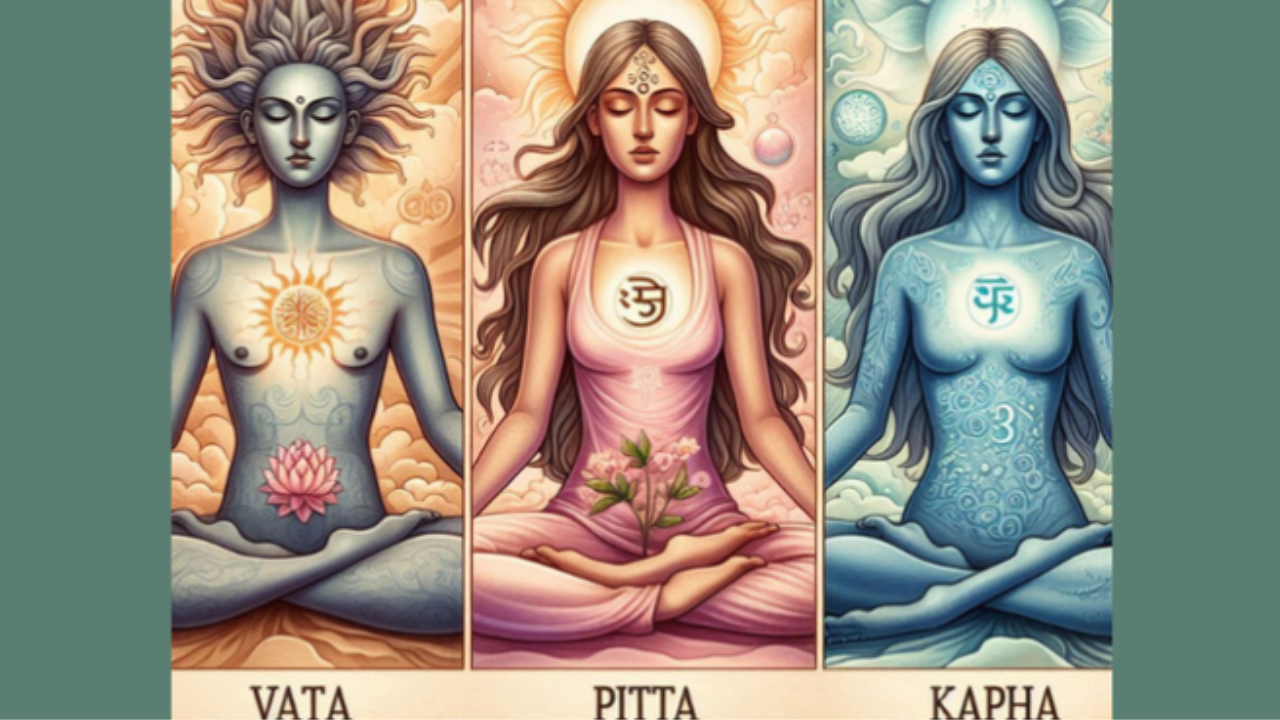
Ayurveda says the human body is a biological combination of the five elements being ether, air, fire, water, and earth.
Ether represents the primordial space and elemental essence foundational to both yogic and Ayurvedic philosophies. Devoid of the solidity of earth, the fluidity of water, the warmth of fire, or the dynamism of wind, Ether epitomizes emptiness in its purest form. It stands as the most refined and subtle among all elemental constituents. Ether provides the space for which all life can manifest.
The word element, it is made up of two words, ele and ment. The prefix ‘ele’ means his or her; and ‘ment’ means mind. So, element means “of his or her mind”. Another way of saying or interpreting that is that the elements are “of Man (or Woman)”. We, the human body, mind, and spirit are (made up “of”) of these five elements.
These five elements combine to form the three Doshas, or the three bodily constitutions. Each one of us can be either one of the three doshas, but most likely we are a combination of two and sometimes all three doshas.
The doshas are Vata, Pitta and Kapha
- Vata is made up of ether and air and is associated with nuclear and electrical energy;
- Pitta is made up of fire and water and is associated with radiant and chemical energy;
- Kapha is made up of water and earth and is associated with chemical and mechanical energy.
The different doshas are made up of different elements which means that they are also made up of different qualities. There are 20 qualities, or Gunas as they are called, that effect each dosha. In fact, each of the doshas is only a name for a grouping of some of these 20 qualities.
Knowing these qualities and acknowledging their existence when we assess our personal dosha is helpful when we think of dis-ease as an imbalance of the dosha. So, it makes sense to bring the body back into balance, or back into ease, we would use the opposite qualities to what we are experiencing. For example, if we are experiencing cold symptoms, then warmth is needed in the way of warm clothes, warm soup, warm lemon water drinks etc. Dry skin? Then increased oil in the diet and topically may assist. These are broad examples, and if you are experiencing chronic issues, then it could be more complicated to understand the pathogenesis and treatment for your dosha. But for now, let’s do a quick overview of the three Doshas.
They are Vata, Pitta and Kapha.

Vata
- Comprising ether and air, Vata governs the essential life force, known as prana in Ayurveda, or the breath of life. Vata embodies qualities such as dryness, lightness, coldness, roughness, subtlety, mobility, and clarity. Physically, individuals dominated by Vata typically possess lithe, adaptable bodies and prominent teeth, alongside small, sunken, and dry eyes. Their appetite and thirst tend to fluctuate irregularly, often leading to digestive issues and malabsorption—a condition characterized by difficulty digesting or assimilating nutrients from food. Malabsorption can impede growth, development, or lead to specific illnesses.
Vata personalities are easily stimulated, alert, and prone to impulsive action, often indulging in daydreaming. While affectionate, they may form relationships out of fear or a sense of loneliness.

Pitta
- Comprised of fire and water, Pitta embodies the fiery element within the body, governing processes such as digestion and chemical transformations. Essentially, all substances entering the body undergo a process akin to cooking, overseen by Pitta. Pitta manifests as hot, sharp, light, liquid, spreading, and slightly oily. Individuals dominated by Pitta typically possess a sensitive and reactive body with a moderate build and weight, experiencing minimal fluctuations in weight. They may exhibit sharp, yellowish teeth with occasionally soft and bleeding gums, alongside bright eyes that are sensitive to light. Pitta types typically display a robust appetite and thirst, gravitating towards cold beverages and sweets.
Pitta personalities excel in learning, comprehending, and concentrating, often showcasing high levels of discipline and leadership qualities. However, they may also tend towards being judgmental, critical, and perfectionistic, with a propensity for easy anger.

Kapha
- Kapha, composed of earth and water elements, constitutes the cellular structure, tissues, and organs within the body. Kapha molecules possess an affinity for cohesion, forming dense clusters that contribute to a more robust, rounded physique. Functions attributed to Kapha include joint and organ lubrication, muscular and skeletal strength, cellular secretions, and memory retention.
Characterized by qualities such as heaviness, slowness, coolness, oiliness, liquidity, sliminess, density, softness, static nature, stickiness, cloudiness, hardness, and grossness, Kapha imparts features of a sturdy and substantial bodily frame, large eyes, strong teeth, and thick, curly hair. Kapha individuals typically have thick, smooth, oily, and hairy skin. Their appetite and thirst remain consistent, although they often experience sluggish digestion and metabolism, predisposing them to weight gain—a challenge they may find difficult to overcome. They derive pleasure from eating, leisurely activities, idleness, and prolonged sleep, while embodying traits of profound faith, love, compassion, and a serene, unwavering mind with a commendable memory.
However, an imbalance in Kapha may manifest as traits of greed, attachment, possessiveness, and laziness.
![]()
One of the most important aspects of this knowledge is understanding your individual constitution and which of these elements might be showing imbalance for you so that you have a good idea of where to start to slowly bring your body as a whole back into balance.
When we are in balance all of our bodily systems (which we explore in the Members Section of The Way of the Warrior Woman) can function and communicate to each other and dis-ease, whether it be weight, sleep or skin issues, can just magically dissipate.
It is truly a beautiful science, and I will never tire of seeing the positive changes in myself, my family and my warrior woman clients when they adopt this knowledge.


